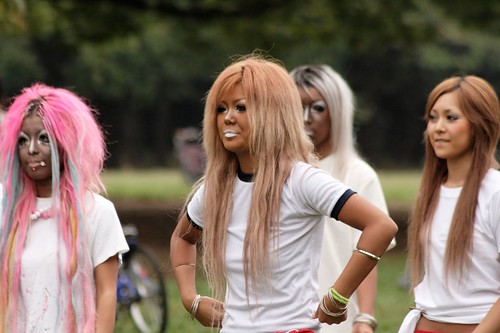The first connection was the "fractured English or pseudo-French" slogans of the "cutie" movement (Kinsella). As presented in class, the ganguro is part of the subculture gyaru - Japanese pronunciation of the English word gal.
 The second connection was the cute writing style and the Disney association. The example to the left is digitally made and many more can be found at Gal International. According to Kinsella, the youth are trying to "rebel against traditional Japanese culture and identify with European culture which they obviously imagined to be more fun" (Kinsella). However, as the ganguro trend is now being taken on by Westerners, both males and females, it is hard to say from where the "fun" inspiration comes.
The second connection was the cute writing style and the Disney association. The example to the left is digitally made and many more can be found at Gal International. According to Kinsella, the youth are trying to "rebel against traditional Japanese culture and identify with European culture which they obviously imagined to be more fun" (Kinsella). However, as the ganguro trend is now being taken on by Westerners, both males and females, it is hard to say from where the "fun" inspiration comes.The third connection is the "cute ladies." Young women were the ones that started the cute style as they have more freedom than men in Japanese society. This is also true to the ganguro trend. It was started by a young teenage girl - named Buriteri - and spread out to the two districts of Tokyo. The male counterpart did not come into the picture until much later.
 The fourth connection is the "cute consumption." As presented in class, the ganguro trend followers appear to be big goods and name brands consumers. Especially the Oneegyaru (Older sister) sub-style that mimics the celebrity-look. On the surface, one can already assume how much these gals consume. Going to tanning salon or buying tanning lotion/fake tans, buying eye makeup, using hair dye, wearing accessories and jewels, etc. I feel like these followers of the trend are the ones that need to be introduced to the Compact Challenge more than any of us in class. It is only my assumption but it seems like they consume even more than an average consumer, whether or not their bought products are cheap. I wouldn't imagine they use second hand goods either. It seems like any youth subculture would involve consumption as the fashion, the look, and the style are symbolic materials of the subculture. It helps make the groups distinctively different and thus, promote the individuality of each group as well as its followers. The followed consequence is the consumption of goods and products. Then how can we go about the problems of the Compact's Challenge? Would we have to compromise the individuality of each group since without material goods consumption there's no distinction between groups? If so then what other marker is as obvious as the look and style? These are the questions that we should also ask ourselves as we follow along with the blogging.
The fourth connection is the "cute consumption." As presented in class, the ganguro trend followers appear to be big goods and name brands consumers. Especially the Oneegyaru (Older sister) sub-style that mimics the celebrity-look. On the surface, one can already assume how much these gals consume. Going to tanning salon or buying tanning lotion/fake tans, buying eye makeup, using hair dye, wearing accessories and jewels, etc. I feel like these followers of the trend are the ones that need to be introduced to the Compact Challenge more than any of us in class. It is only my assumption but it seems like they consume even more than an average consumer, whether or not their bought products are cheap. I wouldn't imagine they use second hand goods either. It seems like any youth subculture would involve consumption as the fashion, the look, and the style are symbolic materials of the subculture. It helps make the groups distinctively different and thus, promote the individuality of each group as well as its followers. The followed consequence is the consumption of goods and products. Then how can we go about the problems of the Compact's Challenge? Would we have to compromise the individuality of each group since without material goods consumption there's no distinction between groups? If so then what other marker is as obvious as the look and style? These are the questions that we should also ask ourselves as we follow along with the blogging.Entry #3
by Nghia Trinh
Sources:
Kinsella, Sharon. "Cuties in Japan."
1st image from Gal International website.
2nd image from Flicker.
No comments:
Post a Comment